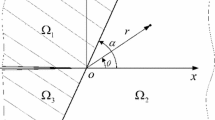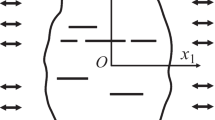Abstract
Anti-plane problem for a singularity interacting with interfacial anti-cracks (rigid lines) under uniform shear stress at infinity in cylindrically anisotropic composites is investigated by utilizing a complex potential technique in this paper. After obtaining the general solution for this problem, the closed solution for the interface containing one anti-crack is presented analytically. In addition, the complex potentials for a screw dislocation dipole inside matrix are obtained by the superimposing method. Expressions of stress singularities around the anti-crack tips, image forces and torques acting on the dislocation or the center of dipole are given explicitly. The results indicate that the anisotropy properties of materials may weaken the stress singularity near the anti-crack tip for the singularity being a concentrated force but enhance the one for the singularity being a screw dislocation and change the equilibrium position of screw dislocation. The presented solutions are valid for anisotropic, orthotropic or isotropic composites and can be reduced to some new or previously known results.
Similar content being viewed by others
References
Wang Z.Y., Zhang H.T. and Chou Y.T. (1986). Stress singularity at the tip of a rigid line inhomogeneity under antiplane shear loading. ASME J. Appl. Mech. 53: 459–461
Chen Y.Z. and Cheung Y.K (1987). Stress singularity coefficients in an infinite plate containing rigid line and applied by concentrated forces. Eng. Fract. Mech. 26: 729–739
Cheung Y.K. and Chen Y.Z. (1989). Multiple rigid line problems in an infinite plate. Eng. Fract. Mech. 34: 379–391
Li Q.Q. and Ting T.C.T. (1989). Line inclusions in anisotropic elastic solids. ASME J. Appl. Mech. 56: 556–563
Ballarini R. (1990). A rigid line inclusion at a bimaterial interface. Eng. Fract. Mech. 37: 1–5
Fan H. and Keer L.M. (1993). Two-dimensional line defects in anisotropic elastic solids. Int. J. Fract. 62: 25–42
Jiang C.P. and Cheung Y.K. (1995). Antiplane problems of collinear rigid line inclusions in dissimilar media. Eng. Fract. Mech. 52: 907–915
Asundi A. and Deng W. (1995). Rigid inclusions on the interface between dissimilar anisotropic media. J. Mech. Phys. Solids 43: 1045–1058
Chen Y.Z. and Hasebe N. (1996). Properties of eigenfunction expansion form for the rigid line problem in dissimilar media. Int. J. Solids Struct. 33: 611–628
Wu L.Z. and Du S.Y. (2000). A rigid line in a confocal elliptic piezoelectric inhomogeneity embedded in an infinite piezoelectric medium. Int. J. Solids Struct. 37: 1453–1469
Chen B.J., Xiao Z.M. and Liew K.M. (2002). On the interaction between a semi-infinite anti-crack and a screw dislocation in piezoelectric solid. Int. J. Solids Struct. 39: 1505–1513
Xiao Z.M., Dai Y. and Chen B.J. (2003). Micro-crack initiation at tip of a rigid line inhomogeneity in piezoelectric materials. Int. J. Eng. Sci. 41: 137–147
Liu Y.W. and Fang Q.H. (2003). Electro-elastic interaction between a piezoelectric screw dislocation and circular interfacial rigid lines. Int. J. Solids Struct. 40: 5353–5370
Fang Q.H., Liu Y.W. and Jiang C.P. (2005). On the interaction between a generalized screw dislocation and circular-arc interfacial rigid lines in magnetoelectroelastic solids. Int. J. Eng. Sci. 43: 1011–1031
Xiao Z.M., Zhang H.X. and Chen B.J. (2005). Micro-crack initiation at the tip of a semi-infinite rigid line inhomogeneity in piezoelectric solids. Int. J. Eng. Sci. 43: 1223–1233
Prasad P.B.N., Hasebe N., Wang X.F. and Shirai Y. (2005). Green’s functions for a bi-material problem with interfacial elliptical rigid inclusion and applications to crack and thin rigid line problems. In. J. Solids Struct. 42: 1513–1535
Xiao Z.M., Zhang H.X. and Chen B.J. (2007). A piezoelectric screw dislocation interacts with interfacial collinear rigid lines in piezoelectric bimaterials. Int. J. Solids Struct. 44: 255–271
Yang S. and Yuan F.G. (1995). Interfacial circular crack in cylindrically anisotropic composites under antiplane shear. Int. J. Solids Struct. 32: 3603–3628
Ting T.C.T. (1996). Pressuring, shearing, torsion and extension of a circular tube or bar of cylindrically anisotropic material. Proc. R. Soc. Lond. A 452: 2397–2421
Ting T.C.T. (1998). The remarkable nature of cylindrically anisotropic elastic materials exemplified by an anti-plane deformation. J. Elast. 49: 269–284
Suo Z. (1990). Singularities, interfaces and cracks in dissimilar anisotropic media. Proc. R. Soc. Lond. A 427: 331–358
Kattis M.A. and Providas E. (1998). Two-phase potentials in anisotropic elasticity: antiplane deformation. Int. J. Eng. Sci. 36: 801–811
Lee K.W., Lim J.H. and Earmme Y. (2001). A screw dislocation interacting with an interfacial crack in two anisotropic thin films with finite thickness. Mech. Mater. 33: 97–103
Muskhelishvili N.L. (1975). Some Basic Problems of Mathematical Theory of Elasticity. Noordhoff, Leyden
Shin H. and Earmme Y.Y. (2004). Interaction of screw dislocation and anisotropic (or isotropic) circular inclusion in isotropic (or anisotropic) matrix. Int. J. Fract. 126: L35–L40
Smith E. (1968). The interaction between dislocations and inhomogeneities—I. Int. J. Eng. Sci. 6: 129–143
Liu Y.W. (1991). Basis singular solutions of anti-plane problem on circular-arc cracks between bonded dissimilar materials. Acta Mech. Solid. Sin. 12: 244–254
Gao C.F. and Balke H. (2003). Fracture analysis of circular-arc interface cracks in piezoelectric materials. Int. J. Solids Struct. 40: 3507–3522
Gao C.F., Kessler H. and Balke H. (2003). Green’s functions for anti-plane deformations of a circular arc-crack at the interface of piezoelectric materials. Arch. Appl. Mech. 73: 467–480
Hirth J.P. and Lothe J. (1982). Theory of Dislocations. Wiley, New York
Juang R.R. and Lee S. (1986). Elastic interaction between general parallel screw dislocations and a surface crack. J. Appl. Phys. 59: 3421–3429
Author information
Authors and Affiliations
Corresponding author
Rights and permissions
About this article
Cite this article
Li, B., Liu, Y.W. & Fang, Q.H. Interaction of an anti-plane singularity with interfacial anti-cracks in cylindrically anisotropic composites. Arch Appl Mech 78, 295–309 (2008). https://doi.org/10.1007/s00419-007-0161-x
Received:
Accepted:
Published:
Issue Date:
DOI: https://doi.org/10.1007/s00419-007-0161-x




